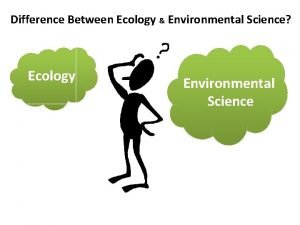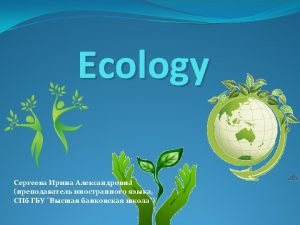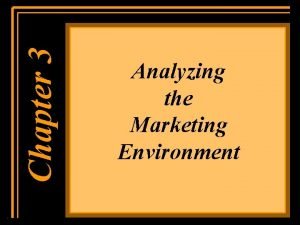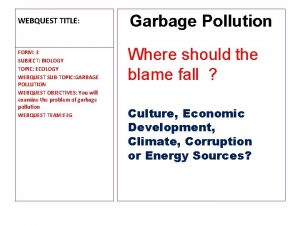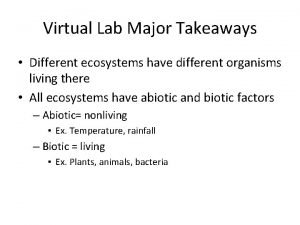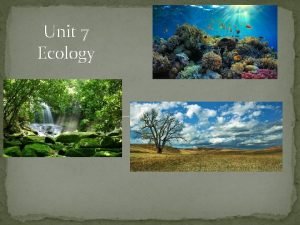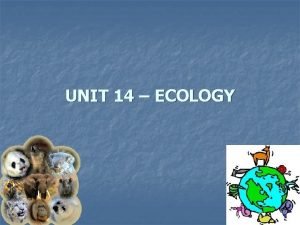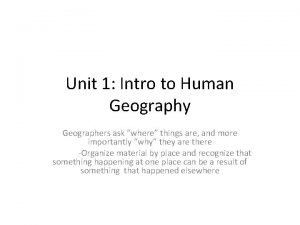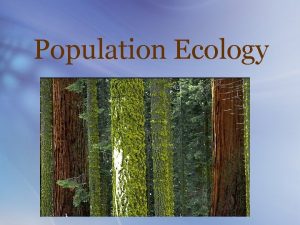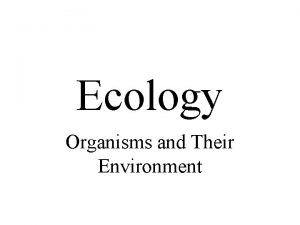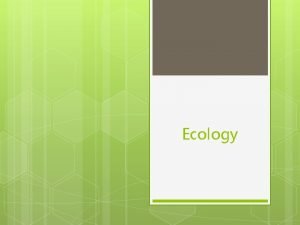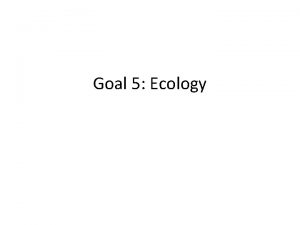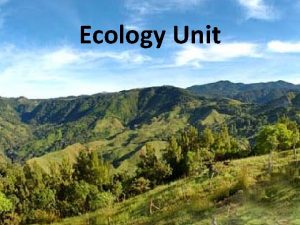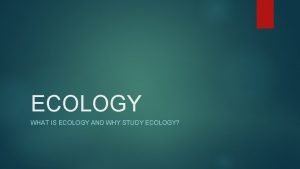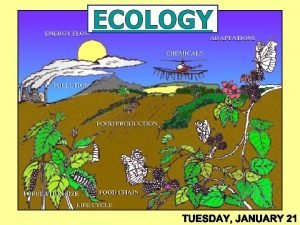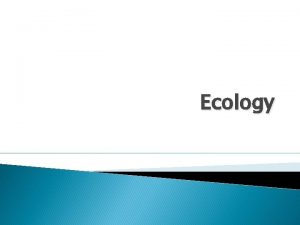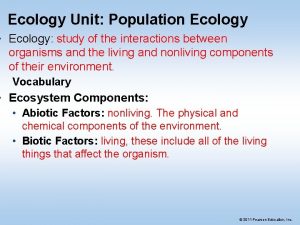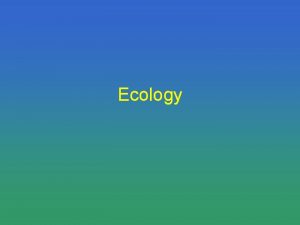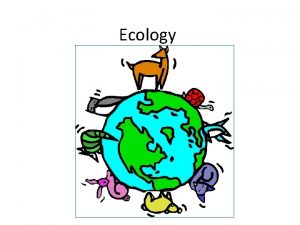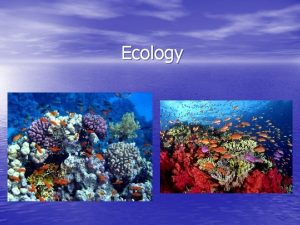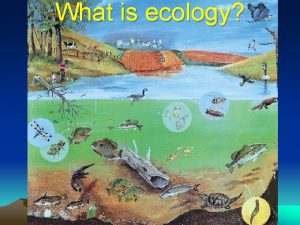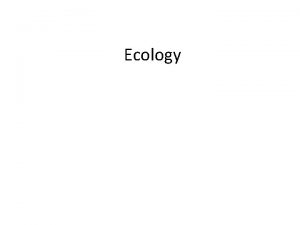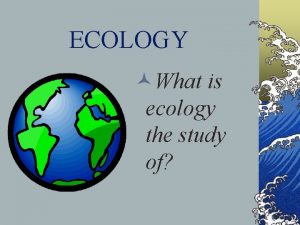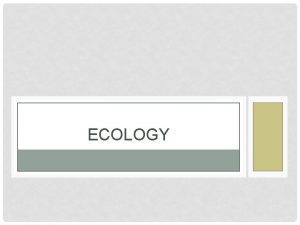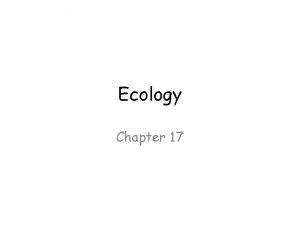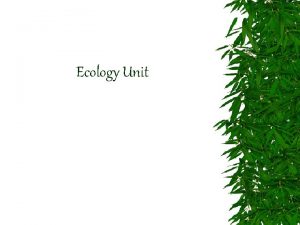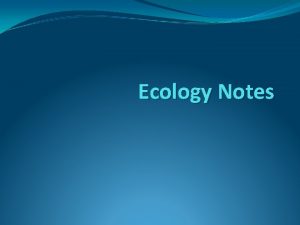ECOLOGY Ecology 1 The study of the environment





























































- Slides: 61

ECOLOGY

Ecology 1. The study of the environment -Ecologists study the desert 2. The study of the interactions in the environment -Ecologists study rattlesnakes, cactus, scorpions, tumbleweeds, etc. & how they interact with each other

ECOLOGISTS study BIOTIC & ABIOTIC factors in the environment & how they influence each other. (Remember that biotic = living and abiotic = non living Ex) In the environment of a RABBIT: rabbits, foxes, grass, weather, dens, water, hunters…etc…

REMEMBER FROM CHAPTER ONE: The levels of organization in humans are: 1. Cell 2. Tissue 3. Organ 4. System 5. Organism (VERY SMALL TO VERY LARGE)

NOW…. THE LEVELS OF ORGANIZATION IN ECOLOGY: (Starts where the other levels left off…) 1. 2. 3. 4. 5. Organism Population Community Ecosystem Biosphere (STILL very small to very large. )

1. ORGANISM One living thing Example: ONE ZEBRA

2. POPULATION Many living things of the same species Example: MANY ZEBRAS in a Savannah in Africa. Must have #, Organism, and Place

Populations Continued § What factors effect a population? 1. Natality – Number of births in an area. 2. Fatality – Number of deaths in an area 3. Immigration – Number of individuals entering an area. 4. Emigration – Number of individuals leaving an area. How are pops calculated? Stay tuned!

3. COMMUNITY ALL LIVING THINGS IN AN AREA Example: Zebras, giraffes, lions, grass, etc.

4. ECOSYSTEM All biotic & abiotic things in the area & the interactions between them. Can be called biomes! Example: Predators, prey, fire, flood, offspring, environment, etc.

5. BIOSPHERE ALL areas on the earth that can support life.

Biosphere I and II? § The Earth is considered to be Biosphere I § Some Biodomes have been manufactured that simulate all of earths biomes.


Ecology Notes Day 2 Let’s start with going back to populations from last class.

POPULATION DYNAMICS Populations CHANGE according to how many organisms are present. Populations can get bigger or smaller depending on the situation

POPULATION GROWTH THERE ARE 2 MAIN TYPES OF POPULATION GROWTH 1. Exponential Growth (The population size gets bigger as time goes by) 2. Natural Growth (Populations hit a CARRYING CAPACITY because of LIMITING FACTORS)

EXPONENTIAL (unlimited) GROWTH HUMANS ARE GROWING EXPONENTIALLY – FOR NOW. *Also known as a “J curve” There is nothing to stop the population from growing. Limiting factors: See Next slide

Limiting Factors § Factors that inhibit a population from growing exponentially. § How do humans deal with limiting factors? § What could be some limiting factors for other populations?

NATURAL GROWTH All other populations hit a CARRYING CAPACITY in their population growth. This means their population cannot keep growing forever.

CARRYING CAPACITY Carrying capacity == the amount of organisms an area can hold Populations cannot have exponential growth because they have LIMITING FACTORS.

POPULATIONS AFFECT EACH OTHER In the wild, 2 populations affect each other’s carrying capacity….

IMMIGRATION / EMIGRATION GROWTH OF A POPULATION CAN BE INFLUENCED BY ORGANISMS MOVING IN OR OUT OF AN AREA. Immigration = moving in = higher pop. Emigration = moving out = lower pop.

Populations Math § Annual Rate of Change – How much does the population grow or shrink each year? -( # natalities + # immigrants) – ( # fatalities + emigrants)

Annual Rate of Change Cont. § A positive number means that the population is growing. § A negative number means that the population is shrinking § EX in one year in a giraffe population: 25 natalities, 10 fatalities, 5 immigrate and 3 emigrate. What is the annual rate of change? .

Answer § 25 + 5 = 30 § 10 + 3 = 13 § 30 – 13 = 17. § The population is growing by 17 giraffes each year.

Population Density § The number of organisms/ the area. § How closely packed are the organisms together. § EX: China 1 billion people in area smaller than the US § We only have 300 million people.

Pops cont § Math: Take number of individuals and divide it by area. § EX 60 giraffes in 3 acres. § 60 / 3 = 20 giraffes/acre

Ecology Notes III § Biodiversity

BIODIVERSITY BIO = LIFE DIVERSITY = DIFFERENCES BIODIVERSITY = DIFFERENCES IN LIFE Biodiversity is a very good thing in an ecosystem…remember…the tropical rainforest has the MOST biodiversity.

EXOTIC SPECIES Species that have been brought in from somewhere else (also known as an ALIEN SPECIES). Examples: Japanese beetles, aphids, zebra mussels, horses, dogs, cats WHY ARE EXOTIC SPECIES BAD IN NATURE? == They take over! The Japanese beetle was brought here to eat the aphids. The aphids were brought here to eat grasshoppers. They both took over the grasslands & now have SPREAD!

Examples of invasives

LOSS OF BIODIVERSITY 1. Normal species= reproducing normally 2. Rare species= reproducing not as quickly as normal 3. Threatened species= have trouble reproducing or are being killed off 4. Endangered species= will become extinct without human intervention 5. Extinct species= completely gone

CONSERVATION How can we help these species? ? CONSERVATION=SAVING A SPECIES 1. Reintroduction programs: take an animal from the wild, help them increase their population & release them back into the wild 2. Make laws: Put species on the endangered/threatened lists; prevent hunting/poaching 3. Preserve habitats: Humans cannot enter certain areas to save the species

Ecology Day 4 – Organism interactions

HABITAT A habitat is where an organism lives out its life. Example: A mosquito lives in damp areas

NICHE A niche is the role (job) an organism has in its habitat. Example: A mosquito’s job is to bite other organisms, feed frogs, spiders, bats, birds and other organisms, & to be annoying.

SYMBIOSIS 2 or more organisms living together in some relationship. 4 MAIN TYPES 1. Mutualism 2. Commensalism 3. Parasitism 4. Predation

1. MUTUALISM Living relationship where both organisms benefit. Example: Alligators & birds (Alligator gets clean & bird gets protection)

2. COMMENSALISM Living relationship where one organism benefits & one is neither benefited nor harmed. Example: Tree & bird (Bird gets a home & tree gets nothing)

3. PARASITISM Living relationship where one organism is benefited & one is harmed. Example: Dog & tick (Dog gets sick & tick gets food)

Michigan connection to Parasitism § Kirtlands Warbler§ Cowbird and Cuckoo bird throw out Warbler eggs and replace them with their own. § Warbler is now endangered, may become state bird.

4. PREDATION Living relationship where one organism benefits & the other is killed. Example: Lion & zebra (Lion kills zebra for food)

End of Material for Pops Test § Materials for Ecosystems test starts on next slide!!!!!!!!1

HOW DO ORGANISMS GET THEIR ENERGY? Remember Homeostasis? Remember Growth and Development? All organisms must obtain energy to maintain homeostasis in their bodies (keep up blood sugar, do the day to day activities that we do) The way that organisms obtain their energy may differ.

How do Organisms get their energy cont. 1. AUTOTROPHS: Create their own energy from the sun **Another term for this is PRODUCER 2. HETEROTROPHS: Get energy by eating other things **Another term for this is CONSUMER

AUTOTROPHS (producers) are PLANTS, some bacteria & some protists. They make (produce) their own energy from the sun in a process called PHOTOSYNTHESIS.

HETEROTROPHS (consumers) are ANIMALS, fungi, some bacteria & some protists. They get their energy by eating (consuming) other organisms.

TYPES OF HETEROTROPHS 1. Herbivore: Eat plants Ex: cow, hippo, elephant, grasshopper, deer 2. Carnivore: Eat meat (animals) PREDATOR vs. PREY Ex: lion, dog, wolf, frog, spider 3 Omnivore: Eat both plants & meat Ex: bear, fish, raccoon, people 4. Scavenger: Eat dead organisms Ex: vulture, hyena 5. Decomposer: Break down dead matter into nutrients for the soil Ex: bacteria, fungi

Ecosystem Ch 16 notes 1 -2 § Actually they started on the last set

TROPHIC LEVELS ARE LEVELS OF ENERGY IN AN ECOSYSTEM. (The amount of energy DECREASES as you go through an ecosystem…so the bottom level (producers) has the MOST energy) **A food pyramid shows how much energy is in a food chain** hawk snake rabbit rabbit rabbit grass grass grass grass grass grass grass grass

ENERGY & MATTER IN ECOSYSTEMS Energy and matter flow through an ecosystem. We already know that ENERGY gets LESS as you go through a food chain. What happens to the matter in that food chain? It gets LESS too! Example: There are LESS hawks than grass in the food pyramid above.

FOOD CHAINS Show energy flows through an ecosystem when one organism eats another & is then eaten by another, who is eaten by another, etc…. . Arrows point in the direction of flowing energy!

FOOD WEBS Show ALL possible food chains in an area. (not just one possibility. )

Bioaccumulation/ Biomagnification § Write this info down on the bottom/back of your notes § Consider the following food chain: § Algae -> minnow-> walleye-> human If the algae has been contaminated, which organism will receive the most toxins in this food chain?

Bioaccumulation § Answer: You probably thought the minnow right? The answer is actually the human. § Why? § Because humans have to eat a lot of walleye to survive…in turn, the walleye have to eat a lot of minnow.

§ Bioaccumulation/Biomagnification – A toxin will get more concentrated as it goes through a food chain!

CYCLES IN NATURE Certain things are REPLENISHED NATURALLY in the environment…. they go through CYCLES to replenish that substance. 1. 2. 3. 4. WATER CARBON / OXYGEN NITROGEN Phosphorus

WATER CYCLE WATER recycles through 3 main steps

CARBON CYCLE PHOTOSYNTHESIS & RESPIRATION from plants & animals replenish carbon dioxide & oxygen.

NITROGEN CYCLE BACTERIA change ground nitrogen into usable nitrogen (more later)

 Chapter 1 science and the environment
Chapter 1 science and the environment What is niche in biology
What is niche in biology Difference of ecology and environmental science
Difference of ecology and environmental science Environment of business finance
Environment of business finance Ecology study guide answers
Ecology study guide answers Chapter 3, section 1: community ecology answer key
Chapter 3, section 1: community ecology answer key Ecology is the study that helps to preserve
Ecology is the study that helps to preserve Responding to the marketing environment
Responding to the marketing environment Case series
Case series Retrospective cohort study
Retrospective cohort study Work study and method study
Work study and method study Marty lobdell
Marty lobdell Phytogeographical regions of india by d chatterjee
Phytogeographical regions of india by d chatterjee Objective of work study
Objective of work study Difference between time study and motion study
Difference between time study and motion study Hát kết hợp bộ gõ cơ thể
Hát kết hợp bộ gõ cơ thể Ng-html
Ng-html Bổ thể
Bổ thể Tỉ lệ cơ thể trẻ em
Tỉ lệ cơ thể trẻ em Gấu đi như thế nào
Gấu đi như thế nào Tư thế worms-breton
Tư thế worms-breton Bài hát chúa yêu trần thế alleluia
Bài hát chúa yêu trần thế alleluia Kể tên các môn thể thao
Kể tên các môn thể thao Thế nào là hệ số cao nhất
Thế nào là hệ số cao nhất Các châu lục và đại dương trên thế giới
Các châu lục và đại dương trên thế giới Công thức tính thế năng
Công thức tính thế năng Trời xanh đây là của chúng ta thể thơ
Trời xanh đây là của chúng ta thể thơ Mật thư tọa độ 5x5
Mật thư tọa độ 5x5 Làm thế nào để 102-1=99
Làm thế nào để 102-1=99 độ dài liên kết
độ dài liên kết Các châu lục và đại dương trên thế giới
Các châu lục và đại dương trên thế giới Thơ thất ngôn tứ tuyệt đường luật
Thơ thất ngôn tứ tuyệt đường luật Quá trình desamine hóa có thể tạo ra
Quá trình desamine hóa có thể tạo ra Một số thể thơ truyền thống
Một số thể thơ truyền thống Cái miệng nó xinh thế chỉ nói điều hay thôi
Cái miệng nó xinh thế chỉ nói điều hay thôi Vẽ hình chiếu vuông góc của vật thể sau
Vẽ hình chiếu vuông góc của vật thể sau Nguyên nhân của sự mỏi cơ sinh 8
Nguyên nhân của sự mỏi cơ sinh 8 đặc điểm cơ thể của người tối cổ
đặc điểm cơ thể của người tối cổ Giọng cùng tên là
Giọng cùng tên là Vẽ hình chiếu đứng bằng cạnh của vật thể
Vẽ hình chiếu đứng bằng cạnh của vật thể Tia chieu sa te
Tia chieu sa te Thẻ vin
Thẻ vin đại từ thay thế
đại từ thay thế điện thế nghỉ
điện thế nghỉ Tư thế ngồi viết
Tư thế ngồi viết Diễn thế sinh thái là
Diễn thế sinh thái là Dạng đột biến một nhiễm là
Dạng đột biến một nhiễm là Số nguyên tố là
Số nguyên tố là Tư thế ngồi viết
Tư thế ngồi viết Lời thề hippocrates
Lời thề hippocrates Thiếu nhi thế giới liên hoan
Thiếu nhi thế giới liên hoan ưu thế lai là gì
ưu thế lai là gì Hổ đẻ mỗi lứa mấy con
Hổ đẻ mỗi lứa mấy con Sự nuôi và dạy con của hươu
Sự nuôi và dạy con của hươu Sơ đồ cơ thể người
Sơ đồ cơ thể người Từ ngữ thể hiện lòng nhân hậu
Từ ngữ thể hiện lòng nhân hậu Thế nào là mạng điện lắp đặt kiểu nổi
Thế nào là mạng điện lắp đặt kiểu nổi Ecology webquest answers
Ecology webquest answers Communities and biomes virtual lab answers
Communities and biomes virtual lab answers Unit 7 ecology
Unit 7 ecology Parasitism
Parasitism Distortion
Distortion


